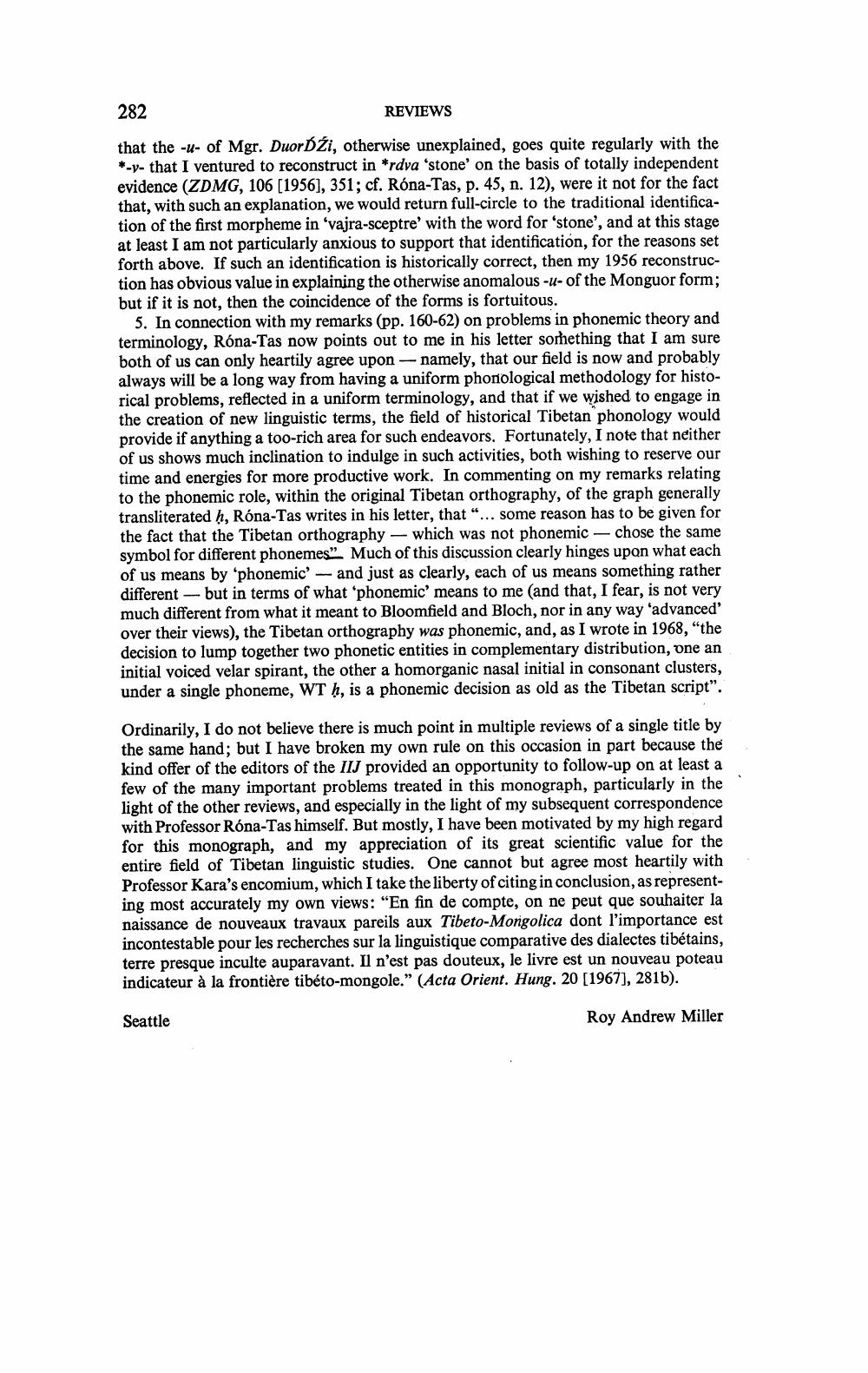________________ 282 REVIEWS that the -u- of Mgr. DuorDzi, otherwise unexplained, goes quite regularly with the *-y- that I ventured to reconstruct in *rdva 'stone' on the basis of totally independent evidence (ZDMG, 106 [1956], 351; cf. Rona-Tas, p. 45, n. 12), were it not for the fact that, with such an explanation, we would return full-circle to the traditional identification of the first morpheme in 'vajra-sceptre' with the word for 'stone', and at this stage at least I am not particularly anxious to support that identification, for the reasons set forth above. If such an identification is historically correct, then my 1956 reconstruction has obvious value in explaining the otherwise anomalous -u- of the Monguor form; but if it is not, then the coincidence of the forms is fortuitous. 5. In connection with my remarks (pp. 160-62) on problems in phonemic theory and terminology, Rona-Tas now points out to me in his letter something that I am sure both of us can only heartily agree upon--namely, that our field is now and probably always will be a long way from having a uniform phonological methodology for historical problems, reflected in a uniform terminology, and that if we wished to engage in the creation of new linguistic terms, the field of historical Tibetan phonology would provide if anything a too-rich area for such endeavors. Fortunately, I note that neither of us shows much inclination to indulge in such activities, both wishing to reserve our time and energies for more productive work. In commenting on my remarks relating to the phonemic role, within the original Tibetan orthography, of the graph generally transliterated h, Rona-Tas writes in his letter, that "... some reason has to be given for the fact that the Tibetan orthography - which was not phonemic - chose the same symbol for different phonemes"Much of this discussion clearly hinges upon what each of us means by 'phonemic' - and just as clearly, each of us means something rather different - but in terms of what phonemic' means to me (and that, I fear, is not very much different from what it meant to Bloomfield and Bloch, nor in any way 'advanced' over their views), the Tibetan orthography was phonemic, and, as I wrote in 1968, "the decision to lump together two phonetic entities in complementary distribution, one an initial voiced velar spirant, the other a homorganic nasal initial in consonant clusters, under a single phoneme, WT h, is a phonemic decision as old as the Tibetan script". Ordinarily, I do not believe there is much point in multiple reviews of a single title by the same hand; but I have broken my own rule on this occasion in part because the kind offer of the editors of the IIJ provided an opportunity to follow-up on at least a few of the many important problems treated in this monograph, particularly in the light of the other reviews, and especially in the light of my subsequent correspondence with Professor Rona-Tas himself. But mostly, I have been motivated by my high regard for this monograph, and my appreciation of its great scientific value for the entire field of Tibetan linguistic studies. One cannot but agree most heartily with Professor Kara's encomium, which I take the liberty of citing in conclusion, as representing most accurately my own views: "En fin de compte, on ne peut que souhaiter la naissance de nouveaux travaux pareils aux Tibeto-Mongolica dont l'importance est incontestable pour les recherches sur la linguistique comparative des dialectes tibetains, terre presque inculte auparavant. Il n'est pas douteux, le livre est un nouveau poteau indicateur a la frontiere tibeto-mongole." (Acta Orient. Hung. 20 [1967), 281b). Seattle Roy Andrew Miller




